
This e-book contains the activities of the 5th team
of the e-Twinning project called “A CULTURAL JOURNEY”.
This book contains legends, tales, stories and
heroes of different countries.
The title of the book was determined
by a questionnaire.
ADVISOR TEACHERS:
Oya ARSLAN
Belgin Feyza KURÇENLİ
Bojana STANKIC
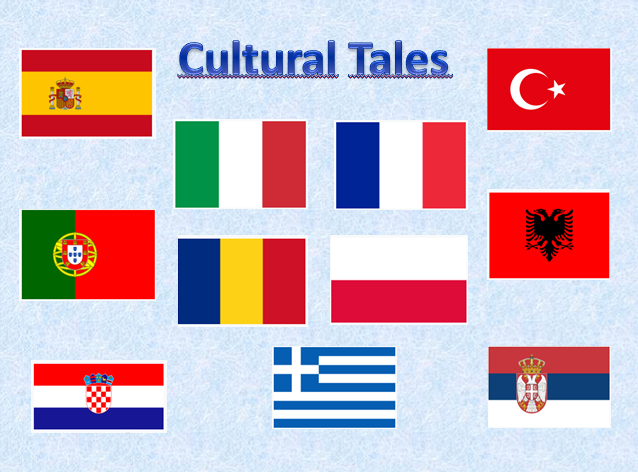
PREFACE FOR THE BOOK OF TRADITIONAL
TALE HEROES
The main purpose of the project is to raise individuals who are integrated with the cultural identity of our age, approach different cultures with respect and tolerance, and see culture as a contribution to their individual and social development thanks to cultural richness and diversity.
This project offered students a great opportunity to learn and embrace the differences between different cultures. It made them aware of both their own values and the values of the partner countries. They learned and experienced different cultures in order to develop and maintain their cultural heritage. Their perspective improved. They learned about the traditions and customs of the project partner countries, their tangible and intangible artistic heritage.
Tales and legends from intangible heritages was an event prepared by the 5th team as a mixed team. The mixed team introduced the most famous fairy tale hero in his country and his fairy tale. The cultural richness was achieved at the international level. Tales provide the opportunity to develop education and language skills in addition to the transfer of cultural heritage. We have seen the contribution of our students to the development of self-expression and communication skills. It contributed to the development of empathy feelings. It has been determined that their relations and sharing with the family have increased. Especially during the pandemic period, the place of traditional fairy tales has become more prominent. This team also made their preparations by using web 2 tools from 21st century skills effectively. This project, which bridges international friendships, has made a significant contribution to the development of teachers and students.
ADVISOR TEACHER:
Belgin Feyza KURÇENLİ
Oya ARSLAN
Bojana STANKIC
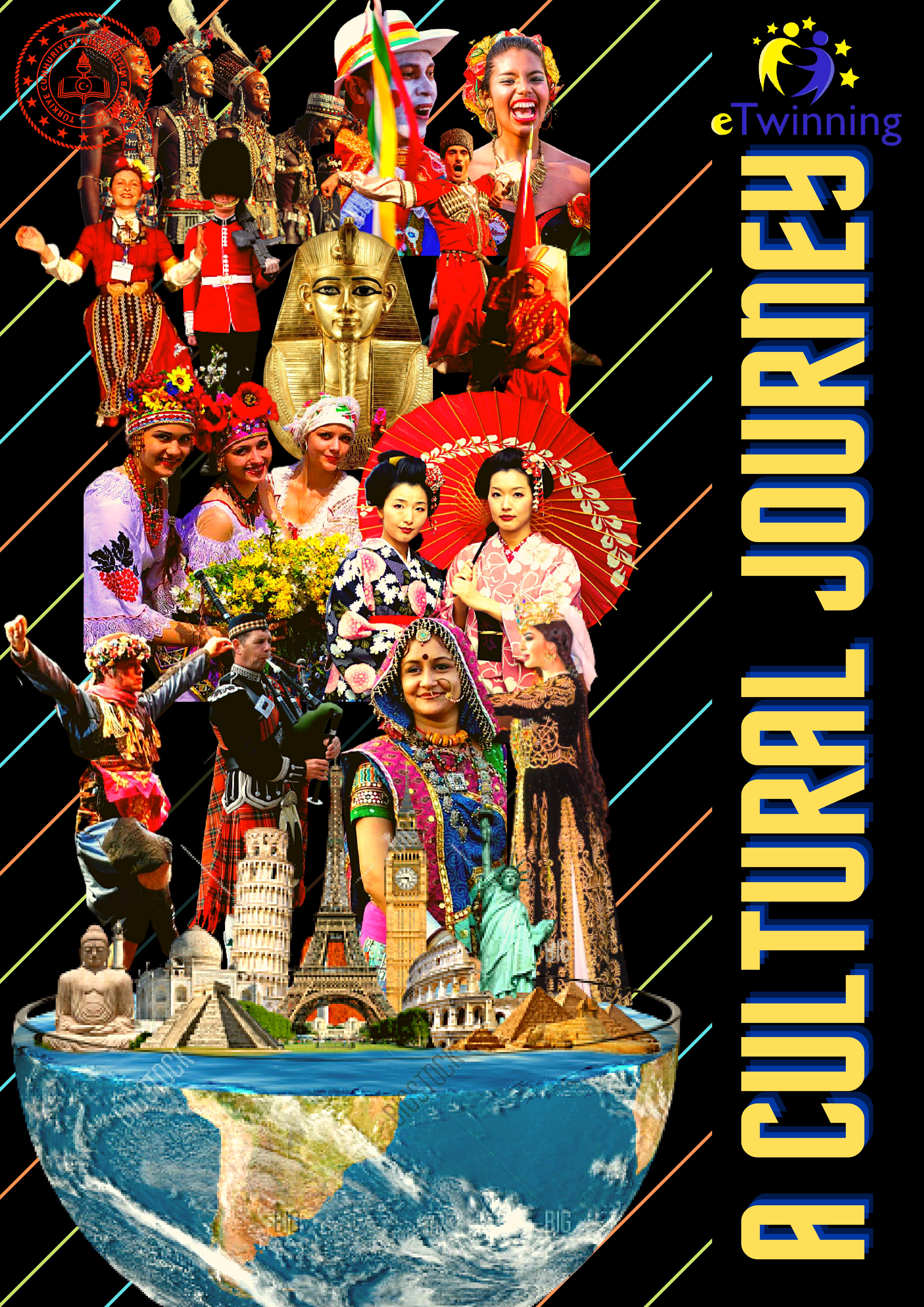
Milica Grebić, Ivana Gaborov and Petar Jovanvić
Hemijsko-prehrambena tehnološka škola,
Beograd, Serbia (The SERBIAN TEAM)
Myth of Serbian Vampire
Who was Sava Savanović?
According to legend, he was a villager, who lived in watermill. He lived in the XVIII century. He was rarely seen throughout the day and was visited only by villagers who wanted to buy flour, but, as the legend says they never returned.
One day, a customer went to buy flour from Sava’s mill, and found him dead. He had two blood spots on his neck, and a yellow butterfly came out of his mouth.
After his death, the mill was abbonded and rumor was spread that it was haunted.

Milica Grebić, Ivana Gaborov and Petar Jovanvić
Hemijsko-prehrambena tehnološka škola,
Beograd, Serbia (The SERBIAN TEAM)
Love story of Strahinja and Radojka
After many years a young villager named Strahinja was in love with a girl called Radojka. He was a poor villager and she came from a wealthy family, and her father didn’t approve their marrage. However, Strahinja wanted to do everything to be with Radojka and win her father’s sympathy. He decided to take over the haunted watermill with intention to start running it again, so that he could eventually get wealthy and marry Radojka. Even though Radojka begged him not to, he did it and the mill revived.
Villagers visited the mill frequently in order to buy grain, and Strahinja’s buisness bloomed. But there was a strange rattling noise each evening. Afraid of the legend about the place, he slept in a small, windowless room which he locked, and kept his gun next to his bed.
Although he was terrified, the thoughts of marrying Radojka kept Strahinja going.

Milica Grebić, Ivana Gaborov and Petar Jovanvić
Hemijsko-prehrambena tehnološka škola,
Beograd, Serbia (The SERBIAN TEAM)
The Kiss of the Yellow Butterfly
One evening, the rattling was even louder and more disturbing than ever before. The inside of the mill rattled, as did the door of Strahinja’s room until the lock broke and a strange man showed up. Shocked, Strahinja yelled in fear and asked the man who he was. It was Sava Savanovic. Without hesitation, Strahinja fired his gun into the man’s chest. Sava screamed and flew away from the house, while Strahinja shouted for help. Along with the villagers, he went to the graveyard, to the grave of Sava Savanovic. Curiously, the earth about the grave was wet. Strahinja started digging. He reached the coffin and opened it. Inside was the tall man who visited him in the mill that night. He had a fresh bullet wound through his chest. Strahinja hammered a metal spike through Sava’s chest. A little, yellow butterfly came out of Sava’s mouth as he died forever. Strahinja ran to Radojka’s home to share the good news. As he got into her room, he noticed the opened window from where the yellow butterfly flew in and landed on Radojka’s lips. Before Strahinja could do anything, the butterfly disappeared into Radojka’s mouth.
She woke up as a vampire with two sharp teeth and attacked Strahinja, drinking his blood and turning him into a vampire. And that’s how they could finally be together forever.

Milica Grebić, Ivana Gaborov and Petar Jovanvić
Hemijsko-prehrambena tehnološka škola,
Beograd, Serbia (The SERBIAN TEAM)
The Legend of Sava Savanović and The Serbian Vampire Love Story
This is a story described in a book, a legend told by generations, and a history perpetuated in a movie.
In 1880, one of the most famous and beloved Serbian authors Milovan Glisić wrote the book “Ninety Years Later” rooting the story of the most famous vampire in Serbia, in literature. It was published 17 years before Bram Stoker’s “Dracula” was published in the United Kingdom.
In 1973, a film was made, based on the book. It is called “Leptirica” (the translation would be “A female butterfly”) and it is considered as the first Serbian horror film.
The vampire folklore goes deeper than a simple legend, and according to the research made about Serbian vampires, it is rooted in people’s beliefs and everyday life.

Milica Grebić, Ivana Gaborov and Petar Jovanvić
Hemijsko-prehrambena tehnološka škola,
Beograd, Serbia (The SERBIAN TEAM)
Saint Sava
The famous St.Sava- Serbia
There are a lot of legends about Saint Sava. He was a prince, then an Othodox monk who lived in the 12th and 13th c.
Saint Sava, known as the Enlightener, was the first Archbishop of the autocephalous Serbian Church, the founder of Serbian law, a very educated man and a diplomat. He is the patron of our schools. We celebrate St.Sava’s Slava every 27th January.
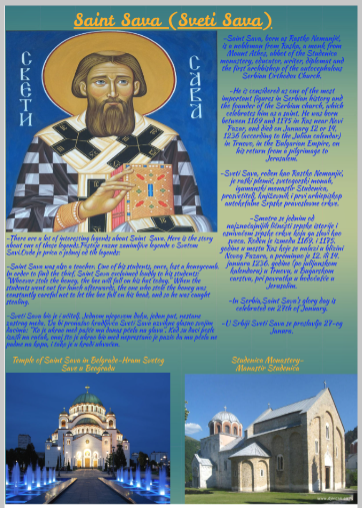
Milica Grebić, Ivana Gaborov and Petar Jovanvić
Hemijsko-prehrambena tehnološka škola,
Beograd, Serbia (The SERBIAN TEAM)
Saint Sava and parents with a small child
The father and mother brought the newborn to St.Sava, into the church and asked him to bless the child and make him happy.
“I will bless him, but only you, his parents, can give him happiness, if you teach him from the very start: to work, to save, not to lie, not to steal, to listen, to be pious, to respect the elders, to be moderate in everything. And, especially if you instruct him to take good care of his health. ”
The parents obeyed the saint and their child became a good, hardworking, honest and pious man.
This was later heard from afar, so many people came from all sides and brought small children to Saint Sava to bless them and make them happy.
And Saint Sava told everyone the same as to the first ones.
Свети Сава и родитељи с малим дететом
Донели отац и мати новорођенче у цркву Светом Сави и замолили да дете благослови и да му срећу.
„Ја ћу га багословити, али му срећу можете дати само ви његови родитељи, ако зарано научите: да ради, да штеди, да не лаже, да не краде, да слуша, да је побожно, да поштује старије, да је у свачему умерено; а нарочито ако га будете упутили да добро чува своје здравље“.
Родитељи послушаше свеца па од њиховог детета постаде добар, радан, поштен и побожан човек. То се после чуло на далеко па су са свих страна долазили многи људи и доводили малу децу Светом Сави да их благослови и да им срећу. А Свети Сава је свима говорио као и онима првима.

Eren/B. Feyza Kurçenli
Edirne Social Sciences High School Edirne/TURKEY
Karagöz and Hacivat
Feast Day
(Karagöz comes, they go inside.)
HACİVAT – Welcome, my Karagöz! …
KARAGÖZ – We found it nice Hacı Cavcav, we found it nice!… Let me kiss your hand!
HACIVAT – Sir, what a kiss is this?…
KARAGÖZ – My patakes, huh, didn’t you learn? Of course, hand kissing is not a feast …
HACIVAT – Okay, I know, what holiday is this on the first day of the feast?
KARAGÖZ – Alas, no matter how many times it is, is it bad to have a holiday?
HACIVAT – Will it be bad for me? Eid is good, feasting is very nice, but …
KARAGÖZ – Well, it is better than all that I kiss your hand whenever I get the chance on the first day of Eid.
HACIVAT – Enough is enough, sir! After the eid prayer, we had a feast in the mosque in the morning.
KARAGÖZ – Don’t lie! I celebrated outside because it would be a shame for everyone to get a holiday tip.
HACIVAT – Whatever it is… We walked together, you feasted on leaving our homes again! I didn’t make a sound again.
KARAGÖZ – Let me see it, especially when it makes a sound. I shout “Hacivat does not celebrate with me, does not have his hand kissed”.
HACIVAT – I am afraid that anybody who believes in you will be disgraced on the feast day.
KARAGÖZ – You are doing well, Hacı Cavcav!…
HACIVAT – I am doing well, if you are the only one who kisses his hand constantly, I will agree with him. While your grandchildren were still in the mosque, there was a queue behind you.
KARAGÖZ – Do not break your mouth, I do not say holidays. Am I the meatballs, am I a cat, and the tail is behind me?
HACIVAT – So, as you kiss my hand, I see that they are lined up behind you.
KARAGÖZ – What will happen?… They will line up behind you, but after you will I kiss the hands of my children and grandchildren?
HACIVAT – May God bless you! It is not like that… I mean, I do not say anything about them kissing their hands after you.
KARAGÖZ – So what does that mean?
HACIVAT – You don’t get out of my way without your tip.
KARAGÖZ – We do so for your sake.
HACIVAT – Let’s see how does that happen?
KARAGÖZ – Köftehor, what would people say if we kissed hands and did not receive our holiday tip?
HACIVAT – They don’t say anything …
KARAGÖZ – They would say, “Hacivat did not tip his children and grandchildren with Karagöz, who kissed his hand during the holiday, it was a shame”.
HACIVAT – As a matter of fact, if they do not know the lining of the matter, they will shame it. But if I tell you how many times you have kissed my hand to get a tip from me, what do they say to you?
KARAGÖZ – They don’t say anything, they don’t blame me.
HACIVAT – God, God, why? …
KARAGÖZ – Köftehor, you are Hacivat, I am Karagöz! … They both laugh and say, “Well done, Karagöz is a clever man who knows his job…”.
HACIVAT – I will not laugh. Hah hah hah!…
KARAGÖZ – Hah hah ya, I’ll make you laugh right now. Don’t think I forgot, let’s give my hand kissing holiday tip, Hacı Cavcav!
HACIVAT – Well, it will be a little, sorry! (It gives.)
KARAGÖZ – It does no harm, you can finish it later! (Gets.)
HACIVAT – How did you come alone this time?
KARAGÖZ – Who said I came alone? The offspring are also on their way. You prepare the coins.
HACIVAT – Oh my God, give me patience!
KARAGÖZ – Okay Hacı Cavcav, deal! May Allah give you patience, and you give us a tip as we kiss each holiday. (Karagöz and then Hacivat go.)
Bayramlaşma Bayramı
(Karagöz gelir, içeri girerler.)
HACİVAT – Karagöz’üm hoş geldin!…
KARAGÖZ – Hoş bulduk Hacı Cavcav, hoş bulduk!… Ver elini öpeyim!
HACİVAT – Efendim, bu ne el öpmesi?…
KARAGÖZ – Pataklarım ha, öğrenemedin mi? Bayramlaşma el öpmesi tabi…
HACİVAT – Tamam, biliyorum da, bayramın daha ilk gününde bu kaçıncı bayramlaşma?
KARAGÖZ – Köftehor, kaçıncı olursa olsun, bayramlaşma kötü mü?
HACİVAT – Canım kötü olur mu? Bayram güzel, bayramlaşma çok güzel ama…
KARAGÖZ – İyi ya, benim bayramın ilk günü fırsat buldukça senin elini öpmem de hepsinden güzel…
HACİVAT – Artık yeter efendim! Bayram namazından sonra sabah câmide bayramlaştık.
KARAGÖZ – Yalan söyleme! Bayram bahşişi almak herkesin içinde ayıp olur diye dışarıda bayramlaştım.
HACİVAT – Her ne ise… Beraber yürüdük, evlerimize ayrılırken tekrar bayramlaştın! Yine ses çıkarmadım.
KARAGÖZ – Hele ses çıkar da göreyim. “Hacivat benimle bayramlaşmıyor, elini öptürmüyor” diye bağırırım.
HACİVAT – Zaten ben de, sana inanan çıkar da eşe dosta bayram günü rezil olurum diye çekiniyorum.
KARAGÖZ – İyi yapıyorsun Hacı Cavcav!…
HACİVAT – İyi yapıyorum ya, durmadan elini öpen sadece sen olsan ona da razıyım. Çocukların torunların daha câmide iken senin arkanda kuyruk olmaya başladı.
KARAGÖZ – Ağzını bozma, bayram demem pataklarım. Köftehor ben kedi miyim de arkamda kuyruk uzasın?
HACİVAT – Yani, sen elimi öperken bir bakıyorum ki onlar da arkanda sıraya girmişler.
KARAGÖZ – Ne olacak ya?… Senin arkanda sıraya girecekler de, senden sonra ben çocuklarımın, torunlarımın mı elini öpeceğim?
HACİVAT – Allah iyiliğini versin! Öyle değil… Yani onların da senden sonra el öpmelerine de bir şey dediğim yok amma.
KARAGÖZ – Eeee, amması ne demek oluyor?
HACİVAT – Bahşişini almadan önümden çekilmiyorsunuz.
KARAGÖZ – Senin iyiliğin için öyle yapıyoruz.
HACİVAT – O nasıl oluyor bakalım?
KARAGÖZ – Köftehor, el öpüp de bayram bahşişimizi almasak görenler ne der?
HACİVAT – Hiçbir şey demezler…
KARAGÖZ – Ben öğretirim. “Hacivat, bayramda elini öpen Karagöz ile çocuklarına ve torunlarına bahşiş vermedi, çok ayıp etti” derler.
HACİVAT – İşin aslını astarını bilmezlerse tabii ayıplarlar. Fakat ben de senin çocuklarını torunlarını peşine takıp, benden bahşiş almak için kaç defa elimi öptüğünü söylersem ya sana ne derler?
KARAGÖZ – Bir şey demezler, beni ayıplamazlar.
HACİVAT – Allah Allah, neden?…
KARAGÖZ – Köftehor, sen Hacivat’sın, Ben Karagöz’üm!… Hem gülüp geçerler, hem de “Aferin, Karagöz ne akıllı, işini bilen adammış…” derler.
HACİVAT – Hiç güleceğim yoktu. Hah hah hah!…
KARAGÖZ – Hah hah ya, ben seni şimdi iyi güldürürüm. Unuttum zannetme de hele şu el öpme bayram bahşişimi ver bakalım Hacı Cavcav!
HACİVAT – Pekâlâ, az olacak ya kusura bakma! (Verir.)
KARAGÖZ – Zararı yok, üstünü sonra tamamlarsın! (Alır.)
HACİVAT – Nasıl oldu da bu sefer yalnız geldin?
KARAGÖZ – Kim dedi yalnız geldiğimi? Çoluk çocuk da yola çıkmışlardır. Sen paraları hazırla.
HACİVAT – Aman Allah’ım, sen bana sabır ver!
KARAGÖZ – Tamam Hacı Cavcav, anlaştık! Allah sana sabır versin, sen de bize her bayramda el öptükçe bahşiş ver. (Karagöz ve sonra Hacivat giderler

Zeynep/B.Feyza Kurçenli
Edirne Social Sciences High School Edirne/TURKEY
Nasreddin Hodja’s Life
Nasreddin Hodja was born in the village of Hortu of city of Konya in 1208. After receiving his basic education, he received a madrasah training in Sivrihisar. With the death of his father, he returned to his village and started to work as an imam there. After a while, he immigrated to Akşehir. He became a dervish and belonged to the paths of Yesevilik, Rufailik and Mevlevi ( Schools of Sufism). He worked in civilian duties in Akşehir and was lived for around Akşehir province for a short time.
He died in Akşehir in 1284 and was buried in present tomb. The legendary personality that developed around the stories told in the name of Nasreddin Hodja spread throughout the century he lived. In addition to the known personality and stories of Nasreddin Hodja, he is found in stories that suggest that he is a stupid person. Not all of these stories, which spread from language to language over time, are not true.
Nasreddin Hodja was a guardian who showed people the right way, told good deeds, guided the truth, and avoided bad deeds. While doing this work, he has taken a unique path by nature.
In addition, it was revealed that Nasreddin Hodja was not a legendary person, but a righteous Muslim who lived in the time of the Anatolian Seljuks in the thirteenth century. Because his witnesses are not expressions of ridiculous events that have happened to a person, but seemingly laughable expressions that actually express subtle wisdom.
Nasreddin Hodja, who is loved by people, is devoted to the belief of Islam. It has succeeded in both surprising and making everyone laugh with its point of readiness. He approached the social problems encountered in social life with a humorous style, and in his anecdotes, he explained the structure, thought and view of the Anatolian people. In the essence of his jokes, the understanding of directing people to the good and the right, revealing the flaws and mistakes by combining them with jokes is dominant.
The information about Nasreddin Hodja’s life was mixed with rumors and gained extraordinary qualities due to the extreme love of the people for him. Among these rumors, there is even that he met with Seljuk Sultans, established a relationship with Mevlana, talked to Timur, who lived at least seventy years after him, and appeared in several places.
There is a work named Saltukname, which was copyrighted in 1480, to the oldest known narrative of the written culture belonging to Nasreddin Hodja himself. It is also a collection of Nasreddin Hodja that sold a book called Povest o Hoco Nasreddine. The anecdotes, mythological elements, features and messages that were compiled in this work were used in education and training in many countries. Nasreddin Hodja is remembered with many sentences.
As an example of Nasreddin Hodja’s words, “the one who gives the money plays the flute”, is one of them. The legendary personality Nasreddin Hodja, whose jokes are circulated from language to language and is remembered with many words, remained in everybody’s mind as in the anecdotes.
Nasreddin Hoca Hayatı
Nasreddin Hoca 1208 senesinde Hortu Köyü’nde doğmuştur. Temel eğitimini almasının ardından Sivrihisar’da bir medrese eğitimi almıştır. Babasının ölmesi ile köyüne dönmüş ve burada imamlık görevine başlamıştır. Bir dönem sonra ise Akşehir’e göç etmiştir. Burada derviş olmuş ve Yesevilik, Rufailik ve Mevlevilik yollarında mensup olmuştur. Akşehir’de mülki görevlerde çalışmış ve Akşehir çevresindeki bölgelerde kısa sürelide olsa bulunmuştur.
1284 senesinde Akşehir’de ölmüş ve türbeye gömülmüştür. Nasreddin Hoca’nın adına anlatılan hikayelerin etrafında gelişmiş olan efsanevi kişiliği kendisinin yaşamış olduğu yüzyıl içinde yayılmıştır. Nasreddin Hocanın bilinen kişiliği ve hikâyelerinin yanında aklının eksik olduğunu, aptal biri olduğunu düşündüren hikayelerde bulunur. Zaman içinde dilden dile değişerek yayılan bu hikayelerin hepsi gerçek değildir.
Nasreddin Hoca, insanlara doğru yolu gösteren, iyilikleri bildiren, doğruya sevkeden ve kötülüklerden sakındıran bir veli idi. Bu işi yaparken tabiatı icabı kendisine has bir yol tutmuştur.
Ayrıca, Nasrettin Hoca´nın efsanevi bir kişi değil, on üçüncü asırda Anadolu Selçukluları zamanında yaşamış salih bir müslüman olduğunu ortaya çıkarmıştır. Çünkü onun nükteleri, bir insanın başından geçen gülünç hadiselerin ifadesi değil, görünüşte güldürücü aslında ince hikmetleri dile getiren, düşündürücü latifelerdir.
Ayrıca, Nasrettin Hoca´nın efsanevi bir kişi değil, on üçüncü asırda Anadolu Selçukluları zamanında yaşamış salih bir müslüman olduğunu ortaya çıkarmıştır. Çünkü onun nükteleri, bir insanın başından geçen gülünç hadiselerin ifadesi değil, görünüşte güldürücü aslında ince hikmetleri dile getiren, düşündürücü latifelerdir.
İnsanlar tarafından çok sevilen Nasreddin Hoca, İslam inancına bağlıdır. Hazırcevap olma yönü ile herkesi hem şaşırtmayı hem de güldürmeyi başarmıştır. Toplumsal hayatta karşılaşılan sosyal problemlere mizahi bir üslup ile yaklaşmış, fıkralarında Anadolu insanlarının yapısını, düşüncesini ve olaylara bakışını anlatmıştır. Fıkralarının özünde insanları iyiye ve doğruya yöneltme, kusurları ve hataları espriler ile birleştirerek gözler önüne serme anlayışı hakimdir.Nasreddin Hoca’nın hayatıyla ilgili bilgiler, halkın kendisine olan aşırı sevgisi yüzünden, söylentilerle karışmış, olağanüstü nitelikler kazanmıştır. Bu söylentiler arasında, onun Selçuklu sultanlarıyla tanıştığı, Mevlana ile yakınlık kurduğu, kendisinden en az yetmiş sene sonra yaşayan Timur’la konuştuğu, birkaç yerde birden göründüğü bile vardır.
Nasreddin Hocanın kendisine ait olan yazılı kültürün bilinen en eski olan anlatısına 1480 senesinde telif edilmiş olan Saltukname isimli eser bulunmaktadır. Aynı zamanda Povest o Hoco Nasreddine isimli seri olan bir kitap satışı yapılmış olan bir Nasreddin Hoca derlemesidir. Bu eser içinde derlenmiş olan fıkralar, mitolojik unsurlar, özellikler ve içerdiği mesajlar çok sayıda ülkede eğitim ve öğretim de kullanılmıştır. Nasreddin Hocanın birçok cümlesi ile hatırlanmaktadır.
Nasreddin Hoca’nın sözlerinden örnek olarak “parayı veren düdüğü çalar”, “el elin eşeğini türkü çağırarak arar” bu sözleri verilebilir. Fıkraları dilden dile dolaşan ve birçok sözü ile hatırlanan efsanevi kişilik Nasreddin Hoca herkesin aklında fıkralardaki gibi kalmıştır.
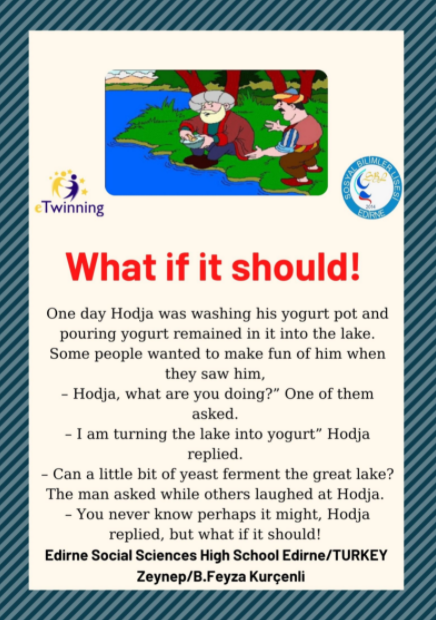
Doruk/B.Feyza Kurçenli
Edirne Social Sciences High School Edirne/TURKEY
Keloğlan Açıl Sofram Açıl Tale;
Once upon a time, there was a very poor husband and wife in the sieve. They were so poor that they couldn’t properly take care of even a bald boy. Keloğlan was a person who, out of spite, did not care about anything.
One day, Keloğlan’s mother called out to her son:
– “Come on, Keloğlan, take those millets to the mill, bring them advice, let’s make bread, let’s eat in the evening.”
Keloğlan loaded his sack of millet. The partridges who looked just as they came to the mill are looking for food.
– “God created them too!” and scattered the millet to the partridges.
Do you know what he said to his mother when he got home at night?
– “There was no miller, I quit millets and came, mother.” said.
The next morning he was sent to the mill again. When he got to the place where the millet scattered, he quickly knocked the staff in his hand. He also saw a giant standing in front of him. Keloğlan, without any fear, the giant shouted:
– “Throw my millets! You fed them to the partridges. What am I going to say now, mama? ”
The giant liked this indifference of Keloğlan.
– “Take this table. When hungry: “Open, my table, open!” he says. You feed your stomach. ” he said, gave Keloğlan a tray.
Keloğlan: “Open, my table, open!” Didn’t the most selected dishes appear on the table?
Keloğlan has had enough to eat. However, one day, how did it happen? The thieves stole Keloğlan’s table. Thereupon, Keloğlan fell on the way of the mill again. He got used to it now; He hit his staff on the ground. This time, he gave not a table, but a donkey. When Keloğlan grabbed the donkey’s head and turned it around, gold began to pour from the animal. Then Keloğlan got on his donkey and went to the bath. To the Hamamcı ( the bath keeper) who tied the donkey to the door: “Do not turn the donkey’s head!” but the man turned the donkey’s head. When he saw the gold, his mind was gone. He changed the donkey and tied another.
Towards Keloğlan again towards the mill road. He found the giant, told what happened. This time the giant gave him a bun.
– He said, “Give me a feast… Call the bathhouse and all those you know…”.
After the feast, as the guests were leaving, the bun pinched one of them.
– “Quick, get the table back!” he started hitting the head on the head of the man.
The man saw that there is no salvation, he brought the table.
The mace also pinched the Bather.
– “Quick, bring back the donkey you stole!” he started hitting the head on the head of the man. Unless he brought it, he kept his collar.
Keloğlan married the sultan’s daughter. At this table, thanks to the donkey, they lived with his wife and mother for a hundred years. If they have fulfilled your wish, let’s get out of it.
Keloğlan Açıl Sofram Açıl Masalı;
Bir varmış, bir yokmuş, evvel zaman içinde, kalbur saman içinde, çok yoksul bir karı-koca varmış. Öyle yoksul, öyle yoksullarmış ki, bir kel oğlancıklarına bile gereği gibi bakamazlarmış. Keloğlan da, inadına, hiçbir şeye aldırış etmeyen bir insanmış.
Günün birinde, Keloğlan’ın annesi oğluna seslenmiş:
— “Hadi, Keloğlan, al şu darıları değirmene götür, öğüt de getir, ekmek yapayım, akşama yiyelim.”
Keloğlan darı çuvalını yüklenmiş. Tam değirmene geldiği sırada bakmış keklikler yiyecek arayıp duruyorlar.
— “Bunları da Tanrı yarattı!” deyip darıları kekliklere saçmış.
Akşama eve döndüğünde anasına ne demiş biliyor musunuz?
— “Değirmenci yoktu, darıları bıraktım geldim, ana.” demiş.
Ertesi sabah gene değirmene yollanmış. Darıları saçtığı yere gelince elindeki değneği hızla yere çalmış. Bir de bakmış karşısına bir dev dikilmiş. Keloğlan, hiç korkmadan, deve bağırmış:
— “Tez ver darılarımı! Onları sen yedirdin kekliklere. Ben şimdi ne diyeceğim anama?”
Keloğlan’ın bu aldırmazlığı devin pek hoşuna gitmiş.
— “Al şu sofrayı. Acıkınca: “Açıl, sofram, açıl!” der. Karnını doyurursun.” demiş, Keloğlan’a bir tepsi vermiş.
Keloğlan: “Açıl, sofram, açıl!” deyince, sofranın üstünde en seçme yemekler belirmemiş mi?
Keloğlan tıka-basa karnını doyurmuş. Gel gelelim bir gün, nasıl olmuş I sa olmuş, hırsızlar Keloğlan’ın sofrasını çalmışlar. Bunun üzerine Keloğlan gene değirmen yoluna düşmüş. Artık alıştı ya; vurmuş değneğini yere. Bu kez de sofra değil, bir eşek vermiş. Keloğlan eşeğin başını tutup çevirince, hayvandan altınlar dökülmeye başlamış. Sonra Keloğlan eşeğine binmiş, hamama gitmiş. Eşeği kapıya bağlamış Hamamcıya da: “Sakın eşeğin başını çevirme!” diyerek sıkıca tembih etmiş ama, adam eşeğin başını çevirmiş. Altınları görünce aklı başından gitmiş Eşeği değiştirmiş, başkasını bağlamış.
Keloğlan doğru gene değirmen yoluna. Devi bulmuş, olanları anlatmış. Bu kez dev ona bir topuz vermiş.
— “Bir şölen ver… Hamamcıyı da, bütün tanıdıklarını da çağır…” demiş.
Şölenden sonra, konuklar giderken, topuz içlerinden birini kıstırmış.
— “Çabuk, sofrayı geri getir!” diyerekten başlamış adamın kafasına kafasına vurmaya.
Adam bakmış ki kurtuluş yok, gitmiş getirmiş sofrayı.
Topuz, hamamcıyı da kıstırmış.
— “Çabuk, çaldığın eşeği geri getir!” diyerekten başlamış adamın kafasına kafasına vurmaya. Getirmedikçe de yakasını bırakmamış.
Keloğlan padişahın kızıyla evlenmiş. Bu sofrayla eşek sayesinde karısıyla, annesiyle yüz yıl yaşamışlar. Onlar ermiş muradına, biz çıkalım kerevetine.

Stjepan I. and Lea V.,
Karlovac Music School, Croatia
THE SLEEPING GIANT OF KLEK
Mount Klek is situated in the south of the Gorski Kotar, next to the city Ogulin. It has a very special status in Croatia because of its mysterious and mystical past, around which many legends were woven. According to folklore, Mount Klek was created after a battle between giants and gods.
In ancient times, the gods would keep all the food and drinks for themselves, which made the giants very angry. One of the giants, named Klek, went to war with Volos, a god who had so much power that he could petrify everyone in the world with his magical sword. Unfortunately, Klek’s fate ended up that way. He got petrified, so his body and head created the mountain that watches over the town of Ogulin. On the mountain peak there is a rock that represents the head of the sleeping giant, with long hair and beard made out of mountain meadows. The body is spread out and takes up the entire mountain. At the end of the mountain there are Klečice rocks that look like giants’ feet.
USNULI DIV S KLEKA
Planina Klek smještena je na jugu Gorskog Kotara, u blizini grada Ogulina. Planina ima vrlo poseban status u Hrvatskoj zbog svoje tajanstvenosti i mistične prošlosti o kojoj su ispričane brojne legende.
Prema narodnoj predaji, planina Klek stvorena je nakon bitke između divova i bogova.
U davnim vremenima bogovi bi zadržavali svu hranu i pića za sebe, što je divove razbjesnilo. Jedan od divova, zvan Klek, krenuo je u rat s Volosom, bogom koji je imao toliko moći da je svojim čarobnim mačem mogao okameniti sve na svijetu.
Nažalost, sudbina Kleka završila je upravo tako. Bio je skamenjen pa su njegovo tijelo i glava stvorili planinu koja bdije nad gradom Ogulinom.
Na planinskom vrhu nalazi se stijena koja predstavlja glavu usnulog diva s dugom kosom i bradom načinjenom od planinskih livada. Tijelo je ispruženo te zauzima cijelu planinu. Na kraju ima stopala koja su predstavljena stijenama Klečice.

Stjepan I. and Lea V.,
Karlovac Music School, Croatia
WITCHES, FAIRIES AND ELVES ON THE MYSTICAL MOUNT KLEK
There is a legend about witches, fairies and elves that want to wake the sleeping giant from his slumber.
When the skies above Ogulin turn dark with storm clouds and strong wind, the local people know it’s time to go into their houses, because witches, fairies and elves from all over the world will descend on the mountain.
Witches with large black hats fly and sing on broomsticks, fairies with long blonde hair make loud noises, and elves jump from cloud to cloud, avoiding thunder and lightning, just because they want to wake up the sleeping Klek.
People say, if you find yourself in the Ogulin area during thunderstorms, remember to look up at Mount Klek, and if you’re lucky, you might see witches flying around.
VJEŠTICE, VILE I VILENJACI NA MISTIČNOM KLEKU
Ova legenda govori o vješticama, vilama i vilenjacima koji žele probuditi uspavanog diva iz njegovog sna.
Kada se nad Ogulinom krenu navlačiti tamni oblaci i krene puhati jak vjetar, lokalno stanovništvo zna da je vrijeme za odlazak u svoje domove jer će se vještice, vile i vilenjaci, iz cijelog svijeta, spustiti na planinu.
Vještice s velikim crnim šeširima, lete i pjevaju na metlama, vile duge plave kose proizvode glasne zvukove, a vilenjaci skakuću s oblaka na oblak, izbjegavajući grmljavinu i munje, zato što žele probuditi usnulog Kleka.
Ljudi kažu, da ako se za vrijeme oluje nađete na području Ogulina, sjetite pogledati planinu Klek i ako imate sreće, možda ćete vidjeti vještice kako lete uokolo
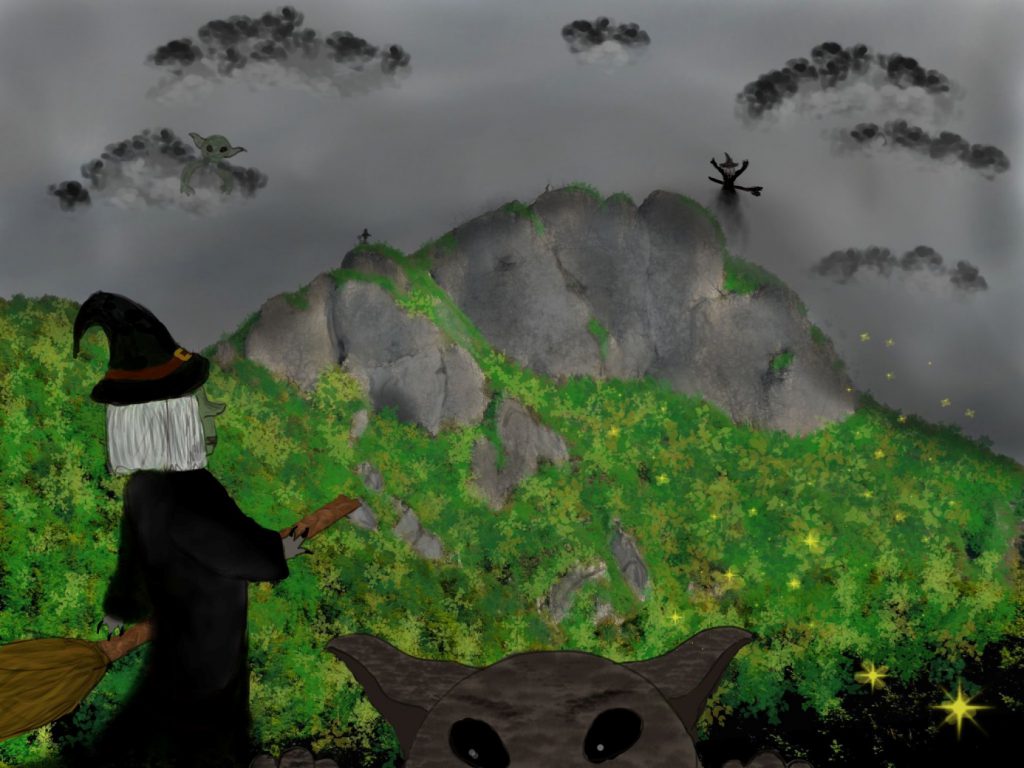
Theofania F.,
5th Gymnasium of Kalamata, Greece
THE HUNGRY MONK-I
The night before the Lent fast had begun a monk in charge of a monastery gave precise and very strict orders to his monks that no one should light a fire for forty days. However, a young monk was not able to keep fasting, and 20 days into the fast grew very hungry. The head monk sent the young monk to get eggs from the monastery chicken. While the young monk collected the eggs he placed one egg in his pocket. The young monk eagerly ran back to his compartment, and started to think of a way to cook the egg in a manner that no smoke would be made, seen, or smelled, and result in him being found out.
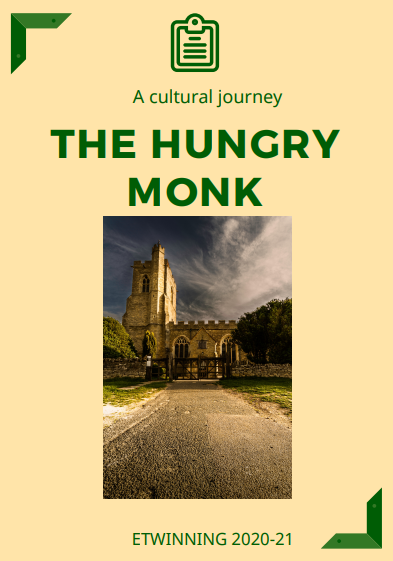
Theofania F.,
5th Gymnasium of Kalamata, Greece
THE HUNGRY MONK-II
The young monk saw a candle and quickly placed the egg on the handle of a large church key using it to hold the egg in place while it cooked. The monk in charge saw that the door was closed and realized something was wrong as the monks tended to leave their doors open. He walked to the door and peered in, seeing what was happening the head monk immediately opened the door and yelled “What are you doing?” The young monk quickly replied “It is not me, but rather this is the devil’s trick. The Devil then appeared and said “No I did not do this … as I could never have thought of it.
Το βράδυ πριν από τη νηστεία, ο μοναχός που ήταν υπεύθυνος για ένα μοναστήρι έδωσε ακριβείς και πολύ
αυστηρές εντολές στους μοναχούς του ότι κανείς δεν πρέπει να ανάψει φωτιά για σαράντα ημέρες. Ωστόσο, ένας νεαρός μοναχός δεν μπόρεσε να συνεχίσει τη νηστεία, και 20 μέρες
στη νηστεία έγιναν πολύ πεινασμένοι. Ο επικεφαλής μοναχός έστειλε τον νεαρό μοναχό να πάρει αυγά από το κοτόπουλο της μονής. Ενώ ο νεαρός μοναχός συνέλεξε τα αυγά, έβαλε ένα αυγό στην τσέπη του.
Ο νεαρός μοναχός έτρεξε με ανυπομονησία πίσω στο διαμέρισμά του, και άρχισε να σκέφτεται έναν τρόπο να μαγειρέψει το αυγό με τέτοιο τρόπο ώστε να μην γίνεται καπνός, να δει ή να μυρίζει καπνός και να έχει ως αποτέλεσμα να ανακαλυφθεί Ο νεαρός μοναχός είδε ένα κερί και γρήγορα έβαλε το αυγό στη λαβή ενός μεγάλου κλειδιού της εκκλησίας χρησιμοποιώντας το για να κρατήσει το αυγό στη θέση του ενώ μαγειρεύτηκε.
Ο υπεύθυνος μοναχός είδε ότι η πόρτα ήταν κλειστή και
συνειδητοποίησε ότι κάτι δεν πάει καλά καθώς οι μοναχοί τείνουν να αφήνουν τις πόρτες τους ανοιχτές. Περπάτησε στην πόρτα και κοίταξε μέσα, βλέποντας τι συνέβαινε, ο μοναχός άνοιξε αμέσως την πόρτα και φώναξε «Τι κάνεις;» Ο νεαρός μοναχός απάντησε γρήγορα «Δεν είμαι εγώ, αλλά μάλλον αυτό είναι το τέχνασμα του διαβόλου». Ο διάβολος τότε εμφανίστηκε και είπε: «Όχι, δεν το έκανα … καθώς δεν θα μπορούσα ποτέ να το σκεφτώ».
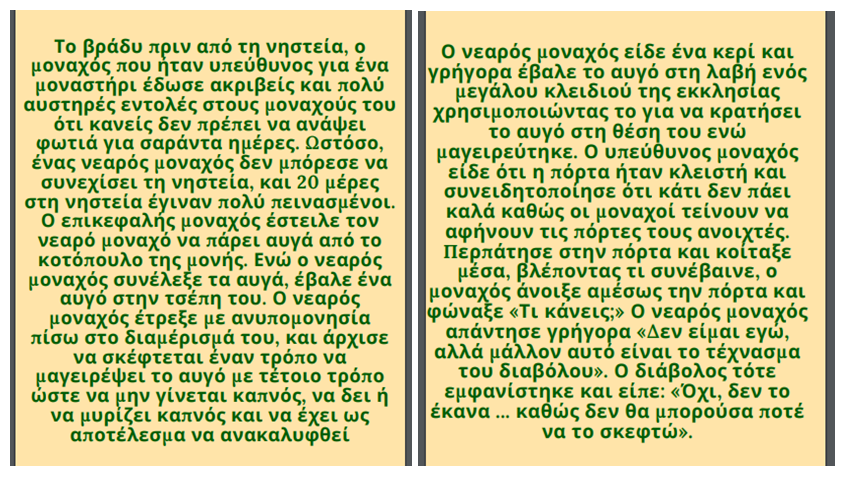
Chrysa T.,
5th Gymnasium Of Kalamata, Greece
THE MOST BEAUTIFUL CHILD!-I
A LONG TIME AGO ALL THE VARIOUS BIRDS HAD ONE TEACHER TO TEACH ALL OF THEIR CHILDREN. ONE DAY THE KIDS WERE BEING VERY UNRULY AND TO PUNISH THE KIDS, THEIR TEACHER ORDERED THEM TO FAST. THE OWL TOOK SOME BREAD AND WENT TOWARDS THE SCHOOL SO THAT IT MAY GIVE ITS’ CHILD SOMETHING TO EAT, AND ON ITS’ WAY, THE OWL MET A PARTRIDGE. THE PARTRIDGE ASKED THE OWL, “WHERE ARE YOU GOING?” THE OWL SAID, “I’M TAKING SOME FOOD TO MY CHILD SO THAT IT MAY HAVE SOMETHING TO EAT.”

Chrysa T.,
5th Gymnasium Of Kalamata, Greece
THE MOST BEAUTIFUL CHILD!-II
THE PARTRIDGE THEN SAID TO THE OWL, “PLEASE TAKE SOME BREAD FROM ME AND GIVE IT TO MY CHILD SO THAT IT MAY NOT GO HUNGRY EITHER.” THE OWL LOOKED AT THE PARTRIDGE AND SAID, “I DO NOT KNOW YOUR CHILD, HOW WILL I RECOGNIZE IT?” THE PARTRIDGE THEN SAID TO THE OWL, “YOU WILL KNOW MY CHILD WHEN YOU SEE IT AS IT IS THE MOST BEAUTIFUL CHILD.”
THE OWL WENT TO THE SCHOOL AND GAVE ITS’ CHILD SOME FOOD TO EAT. WHEN THE OWL LOOKED FOR THE PARTRIDGE’S CHILD IT COULD NOT RECOGNIZE IT, BECAUSE IT COULD NOT FIND ANY CHILD MORE BEAUTIFUL THAN ITS’ OWN. THE OWL THEN RETURNED TO THE PARTRIDGE AND SAID, “TAKE YOUR BREAD AS I CAN FIND NO CHILD MORE BEAUTIFUL THAN MY OWN.” THE MORAL IS THAT NO CHILD IS MORE BEAUTIFUL THAN A MOTHER’S OWN CHILD.
Πριν από πολύ καιρό όλα τα πουλιά είχαν έναν δάσκαλο να διδάξει όλα τα παιδιά τους. Μια μέρα τα παιδιά ήταν πολύ απείθαρχα και για νατιμωρήσουν τα παιδιά, ο δάσκαλός τους τους διέταξε να νηστεύσουν. Η κουκουβάγια πήρε λίγο ψωμί καιπήγε προς το σχολείο για να δώσει στο παιδί της κάτι να φάει και στοδρόμο της, η κουκουβάγια συνάντησε ένα πέρδικα. Η πέρδικα ρώτησε την κουκουβάγια, «Πού θα πας;» Η κουκουβάγια είπε: «Παίρνω λίγο φαγητό στο παιδί μου για να φάει κάτι» Στη συνέχεια, η πέρδικα είπε στην κουκουβάγια, “Παρακαλώ πάρτε λίγο ψωμί από μένα και δώστε το στο παιδί μου, ώστε να μην πεινάει. “Η κουκουβάγια κοίταξε την πέρδικα και είπε, “Δεν ξέρω το παιδί σας, πώς θα το αναγνωρίσω;”Στη συνέχεια, η πέρδικα είπε στην κουκουβάγια: «Θα ξέρεις το παιδί μου όταν το βλέπεις, καθώς είναι το πιο όμορφο παιδί». Η κουκουβάγια πήγε στο σχολείο και έδωσε στο παιδί της λίγο φαγητό. Όταν η κουκουβάγια
έψαχνε το παιδί της πέρδικας δεν μπορούσε να την αναγνωρίσει, γιατί δεν μπορούσε να βρει κανένα παιδί πιο
όμορφο από το δικό του. Στη συνέχεια, η κουκουβάγια επέστρεψε στην πέρδικα και είπε, «Πάρτε το ψωμί σας
καθώς δεν μπορώ να βρω κανένα παιδί πιο όμορφο από το δικό μου». Το ηθικό είναι ότι κανένα παιδί δεν είναι πιο
όμορφο από το παιδί της μητέρας

Chrysa T.,
5th Gymnasium of Kalamata, Greece
Hercules
Brave and powerful Hercules is perhaps the most loved of all Greek heroes. The son of Zeus and Alcmene (a granddaughter of Perseus), Hercules grew up to become a famed warrior. But Zeus’s jealous wife, Hera, made him temporarily insane, and he killed his wife and children. As punishment Hercules performed twelve seemingly impossible labors, which have been the subject of countless works of art and drama. Hercules is often depicted wearing a lion skin and wielding a club.

Theofania F.,
5th Gymnasium Of Kalamata, Greece
Prometheus and the Theft of Fire
A famous hero of greek culture is Prometheus.
He was the one who gave fire to people and was punished from gods for his action.
One day, Zeus distributed gifts to all the gods, but he didn’t care much for humans. The Titan Prometheus, however, because he loved and felt sorry for humans, climbed up on Olympus and stole the fire from Hephaestus workshop, put it in a hollow reed and gifted it to the humans. This way, humans could create fire, warm up and make tools. Zeus became very angry when he heard about this. He took Prometheus to a high mountain, the Caucasus, and chained him on a rock with thick chains made by the smith god, Hephaestus. And every day, Zeus would send an eagle that ate Prometheus’ liver. For thirty years Prometheus remained bound in the Caucasus, until the great hero Hercules, Zeus’ demigod son, released him finally from his torment.

Riccardo Marinozzi, Angelica Izzo, Serena Prosperi, Alessia Fidanza 3A T “V. Moretti”
Myths and Legends of Italy
The White Lady
Biancamaria at the age of 13, was transferred from the family palace in Brescia to the family’s country residence, recently restored by her uncle Bernardino Martinengo, at the end of 1479. Legend has it that Biancamaria died falling into the moat of the castle giving life to the legend of the “White Lady” and that every ten years, on July 20, the same night of her death, her ghost reappears in the castle, dressed in white, holding a gold book containing the secret of his death.

Riccardo Marinozzi, Angelica Izzo, Serena Prosperi, Alessia Fidanza 3A T “V. Moretti”
The Ianara
Ianara was a child born on Christmas day who was born devoted to evil. The Ianara went out during the night to kidnap children or to commit jokes to the unfortunates. This witch had the appearance of an old woman very advanced in years, who lived a normal life during the day, while at night she went out of the house committing her atrocities.
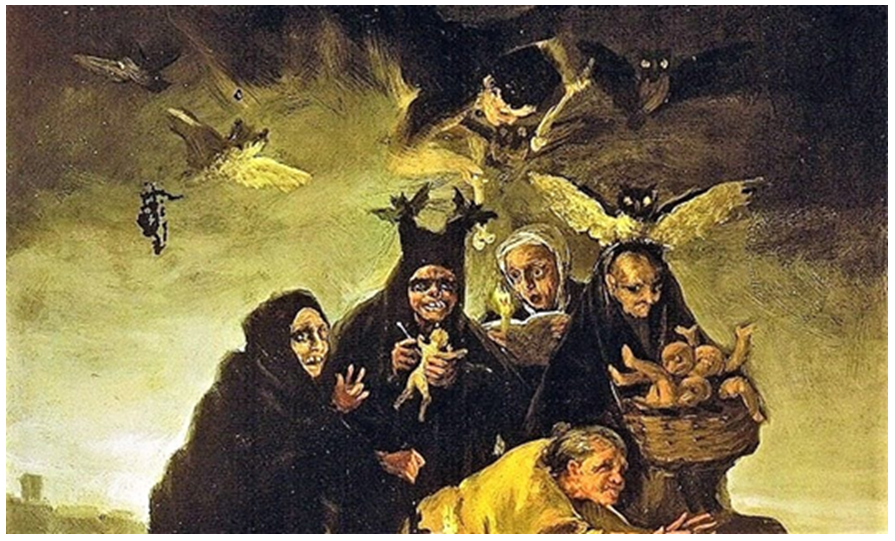
Riccardo Marinozzi, Angelica Izzo, Serena Prosperi, Alessia Fidanza 3A T “V. Moretti”
The Oak of the Witches
The Oak of the Witches is a tree of unreal dimensions located in the hamlet of San Martino in Colle. The legend tells that this tree was the meeting point for the witches who used to do their rites and dance around it. Its flattened shape, with the branches developed horizontally, would be due to the presence of the witches on the foliage. This is the reason why it is called “witches’ oak”.

Paige Spicer
IES Antonio Menárguez Costa-Spain
TRADITIONAL SPANISH STORY:
THE TOAD AND THE MOUSE
THE TOAD WAS PLAYING THE FLUTE ONE DAY, AND THE MOUSE DOESN’T LIKE ANY MUSIC. SO THE MOUSE MADE A DEAL WITH THE TOAD: THEY WERE GOING TO DO A RACE,
IF THE MOUSE WINS HE KEEPS THE FLUTE, BUT IF THE TOAD WINS HE GETS THE MOUSES HOUSE. THE TOAD HAD A PLAN SO HE COULD WIN. HE TOLD HIS WIFE TO WAIT AT THE FINISH LINE AND SHOUT! I WON! THATS WHAT THEY DID. THE MOUSE LOST SO HE WENT TO GO FIND ANOTHER HOME. THE MORALOS THE STORY IS YOU SHOULD NEVER JUDGE A BOOK BY ITS COVER.

Salvador Escobar Hernández
IES Antonio Menárguez Costa-Spain
The Coco
The Coco is a myth from Spain, which is used for when
children do not want to sleep saying: “Duérmete niño,
duérmete ya, que viene el coco y te comerá”.
The Coco is a monster who stay below the bed.
The eighth Canary Island
San Borondón is an island of the Canary archipelago that
apparently appears and disappears over the years that has served as inspiration to universal writers such as Washington Irving, Vicente Blasco Ibáñez or Jorge Luis Borges.
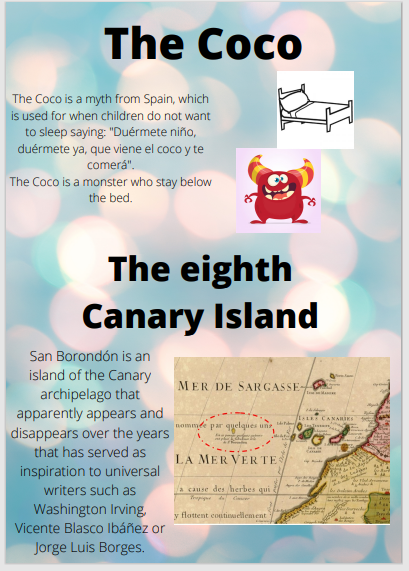
Yolanda Galindo
IES Antonio Menárguez Costa-Spain
Coconut Monster
I am going to tell you about my work on the coconut monster.
People incorporate them into lullabies and many parents use it to scare children to go to bed, saying:
“Go to sleep child, go to sleep now, the bogeyman is coming and will eat you.”

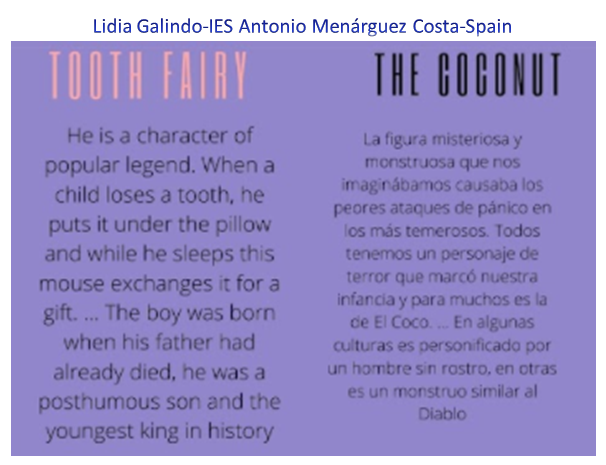
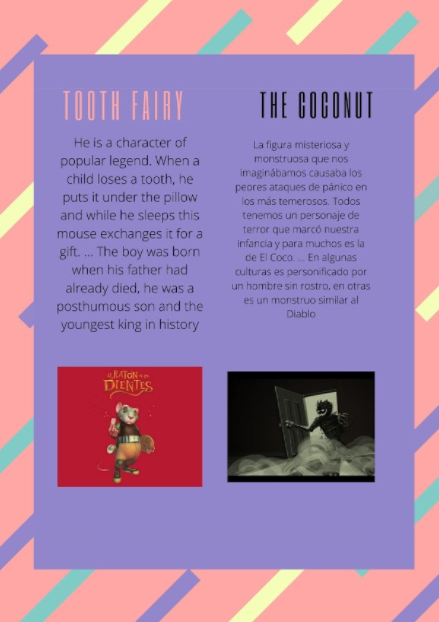
Silivestru Denisa
Colegiul Dobrogean “Spiru Haret”, Tulcea, Romania
ROMANIAN TALES AND MYTHS
Romanian fairy tales…
Before Harry Potter and princess Elsa were capturing the imagination of children and teenagers everywhere, local generations were growing up with the stories written or collected by Ion Creangă and Petre Ispirescu. Their tales are classics of Romanian literature and many of them can also be read in translation.
The Old Man’s Daughter and the Old Woman’s Daughter, by Ion Creangă
The tale contrasts the lazy and badly-behaved old woman’s daughter with the diligent, patient and well-behaved old man’s daughter, who is driven out of her home by the scheming of her stepmother and stepsister. She travels to find work and is rewarded plentifully for the good deeds she performs during her journey and at her found patron. Not something that will happen to the old woman’s daughter when she attempts a similar voyage.
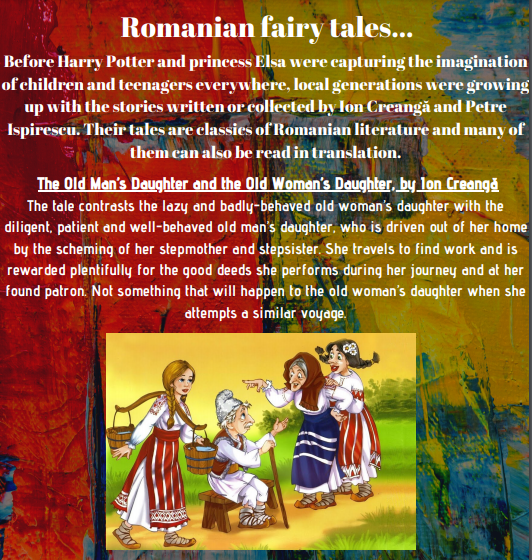
Silivestru Denisa
Colegiul Dobrogean “Spiru Haret”, Tulcea, Romania
The Story
«Once upon a time there was an old man and an old woman who lived in a house. Each of them had a daughter. The old man’s daughter was friendly, hard working and kind, while the old woman’s daughter was lazy, proud and unfriendly. One day, the old woman ordered the old man’s daughter to leave the house. So the good girl left. On her way, she met a dog that was sick and full of fleas. The dog said to her “Please help me, and I will be useful to you someday”. The girl nursed the dog, then went on her way. Later, she met a fountain that was broken and dry. The fountain said to her
“Please help me and I will be useful to you someday”. The girl fixed the fountain and continued her journey.Soon, she met an oven of clay, broken and unused. “Please help me, said the oven, and I will be useful to you someday”. She fixed the oven, mended its cracks, then continued her way. Then, she met a pear tree that was full of caterpillars and had many dry branches. “Please help me, said the tree, and I will be useful to you someday” The girl cleaned the tree and went on. She arrived at the house of Saint Sunday, who was a very wise old woman. “Welcome, young girl, said Saint Sunday. I must go away, but while I’m gone, please wash my children and feed them. And keep some food warm for me, when I come back”. Saint Sunday went away. The girl called the children from the forest, but they were strange animals, some bigger, some smaller. She was not afraid of the strange animals, she washed them and fed them. When Saint Sunday returned, she found good food waiting for her. “Girl, you have done a good job here, she said. Now go upstairs in the attic. There are many boxes, some old, some new and shiny. Choose a box as a reward for your work, whichever you think is right for you”. The girl went to the attic and saw many boxes. She was not greedy, so she chose the smallest box, made of wood. Then she said goodbye to Saint Sunday and started to go back home. On her way, she arrived at the tree. The tree was full of big, yellow, juicy pears. The tree bowed down and let her pick some pears. Then, the girl met the oven. The oven was full of fresh cookies. She ate some cookies, then went on. She met the fountain, that was full of clear water and had two silver glasses on the edge. She drank some water and took the glasses with her. Then she met the dog, who had a necklace of gold. “Take the necklace, said the dog, as a thank you for your help”. She took the necklace, then went on and arrived home. She called her father and they opened the wooden box. From the little box appeared many cows, horses, chicken, pigs, orchards and crops, that filled the garden. “We are rich now”, said the old man, very happy. The old woman and her lazy daughter were very envious. “I’ll go too, said the lazy daughter, I will bring even more riches”. So off she went. She met the dog who asked for her help, but she refused. “Did you have many servants before?” she yelled at the dog and went on. She met the fountain that was broken and dry. The fountain asked her for help, but she replied: “How can I dirty my hands with you?”. She went on and met the oven. The oven asked for help, but she refused in the same way. After that, she met the tree that asked for help too, but she refused again. And she arrived at the house of Saint Sunday. “Girl, please feed and wash my children while I am away. And keep some food for me too when I return”, said Saint Sunday. The lazy girl called the children and the strange animals appeared. “What sort of creatures are these?” she said very disgusted. And she boiled water to wash them, but she burned them with hot water. Then she burned the food too and let it get cold. When Saint Sunday returned and saw the disaster, she remained calm. “Girl, go to the attic and choose one box that you think you deserve for your work”, she said. The lazy girl went upstairs and chose the biggest box, golden and shiny. Then she ran off, without saying a word to Saint Sunday. She arrived at the tree. The tree was full of big, yellow juicy pears, but when she wanted to pick one, the tree became so tall, she could not reach it. She went on and arrived at the oven. The oven was full of warm cookies, but when she wanted to eat, the oven burned her hands. She had to go on hungry. She saw the fountain that was full of clear water and had two silver glasses. She wanted to drink, but the glasses and the water disappeared. She went on thirsty. She met the dog who had a golden necklace. She wanted to take the necklace, but the dog barked and bit her. She arrived home and called the old woman. They opened the shiny big box, but from inside appeared huge monsters that ate them both and then disappeared with the box. The old man and the good daughter remained to live their peaceful lives after that. The good daughter found a good man and got married. And they lived happily ever after.»

Silivestru Denisa
Colegiul Dobrogean “Spiru Haret”, Tulcea, Romania
The Human Foolishness, by Ion Creangă
This story focuses on one man’s search to find anyone more stupid than his family. His search doesn’t take too long as he encounters various examples, from someone trying to capture sunlight in a bucket instead of making a window for his house or someone who attempts to get his cow to climb the ladder to be fed rather than take the fodder down from the barn.
Extract from the story
« It’s been said that once there was a married man, and this man lived together with his mother-in-law. His wife, who had a suckling child, was rather dumb; even the mother-in-law was no smartie. One day, our man leaves the house to go about his business, like every man does. His wife bathed the
baby, swaddled and nursed him, then she put him in bed next to the stove, because it was winter, and then swung it and sang a lullaby, until he fell asleep. After he fell asleep, she sat there thinking, then began to wail as loud as her mouth allowed: “Oh no! My baby, my baby!” Her mother, who spun behind the chimney, startled, threw away her tools and, jumping up selflessly, asked with dread:
– What is it, mother’s dearest, what’s with you?
– Mother, Mother! My child will die!
– When and how?
– Here’s how. See the salt block on the chimney?
– I see it. So?
– If the cat climbs up there, it will throw it straight to my baby’s head and kill him!
– Woe to me, right you are, my girl; the little one’s days are numbered!
And, looking ahead to block of salt on the chimney and with their hands clenched, as if someone had tied them, they began to wail both, like crazy, as if the house was boiling. While they were in the midst of self-disfigurement, the man of the house entered the door, hungry and worried.
– What is it? What startled you, witches?
Catching their breath, they began to wipe off their tears and tell him while mourning about the happening that had yet to happen. The man, after listening to them, said with wonder:
– Aye! I saw many fools in my life, but never like you two. I’ll go roam the land! And if I find anyone dumber than you, I’ll be coming home, but if not, I won’t. »

Silivestru Denisa
Colegiul Dobrogean “Spiru Haret”, Tulcea, Romania
Everlasting Youth and Eternal Life, collected and recounted by Petre Ispirescu
This is the story of a king and queen who promise their unborn son, who wouldn’t stop crying, that they would gift him‘ youth without age and life without death’. As he grows up and the promise cannot be fulfilled, he decides to go encounter it himself. And although he does find the place where eternal youth is possible an unexpected event awakens in him the longing to return home, among the mortals.
Extracts from the story-I
« But when the hour of its birth came, the child began to scream in a way no magic arts could silence. The emperor commenced to promise it all the good things the world contained, but it was impossible to quiet it. “Hush, father’s pet,” said the emperor, “I will give you this or that kingdom; hush, my son, I will give you this or that princess for your wife.” At last, when he saw the child would not stop, he added: “Hush, my boy, I will give you everlasting youth and life without end.” Then the prince stopped crying; the courtiers beat drums and blew trumpets, and there were
great rejoicings throughout the empire for a whole week.
The older the boy grew, the more thoughtful and reflective he became. He went to the schools and the philosophers and gained every kind of learning, so that the emperor died of joy and came to life again. The whole realm was proud of having a prince so wise and learned, a second King Solomon. But one day, when the lad had just reached his fifteenth year and the emperor sat at a banquet with the nobles and grandees of the country, the handsome prince rose, saying: “Father, the time has come, you must now give me what you promised at my birth!” When the emperor heard this he grew very sorrowful and answered: “Why, my son, how can I give you an impossible thing? If I promised it to you then, it was only to hush you.” “If you can’t give it to me, father, I shall be obliged to wander through the whole world till I find
what was promised to me, and for which I was born.”»
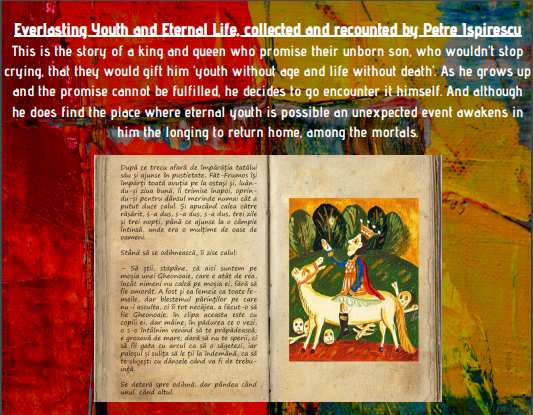
Silivestru Denisa
Colegiul Dobrogean “Spiru Haret”, Tulcea, Romania
The Story-II
« When the young hero saw her, he stood still as though turned to stone. But as she gazed at him she pitied him and said: “Welcome, my handsome prince. What do you seek here?” “I seek everlasting youth and life without end.” Then he dismounted from his horse and entered the palace, where he found two other ladies, both of the same age, the elder sisters of the first one. He began to thank the fairy for having delivered him from danger, but she and her sisters, to show their joy, had a handsome banquet served in golden dishes. They gave the horse liberty to graze wherever it chose, and afterward made it acquainted with all the wild beasts, so that it might rove about the forest in peace. The ladies entreated the prince to stay with them, saying that it was so tiresome to be alone. He did not wait to be asked a second time, but accepted the offer with the satisfaction of a man who has found precisely what he sought. By degrees they became accustomed to live together; the prince told them his story and related what he had suffered before meeting them, and after some time he married the youngest sister. At their wedding permission was granted to him to go wherever he liked in the neighborhood; they only begged him not to
enter one valley, which they pointed out, otherwise some misfortune would befall him; it was called, they said, the Valley of Lamentation. The prince spent a very long time at the palace without being aware of it, for he always remained just as young as he was when he arrived. He wandered about the woods without ever having a headache. He amused himself in the golden palace, lived in peace and quiet with his wife and her sisters, enjoyed the beauty of the flowers, and the sweet, pure air. He often went hunting; but one day, while pursuing a hare, he shot two arrows at it without hitting the animal. Angrily chasing it he discharged a third arrow, which struck it, but in his haste the luckless man had not noticed that he had passed through the Valley of
Lamentation while following the game. He picked it up and turned toward home, but was suddenly seized with a longing for his father and mother. He did not venture to speak of this wish to his wife, yet by his grief and restlessness both she and her sisters instantly perceived his condition. “Oh! luckless prince, you have passed through the Valley of Lamentation,” they said in terror. “I did so, my dear ones, without meaning to be so imprudent, but now the longing to see my parents is killing me! Yet I can not forsake you. I have already spent several days with you and have no cause to complain. So I’ll go and see my parents once more, and then come back to you, never to leave you again.” “Do not quit us, beloved prince! Your parents died two or three hundred years ago, and if you go, we fear you yourself will never return; stay with us, for a presentiment of evil tells us that you will perish!” »
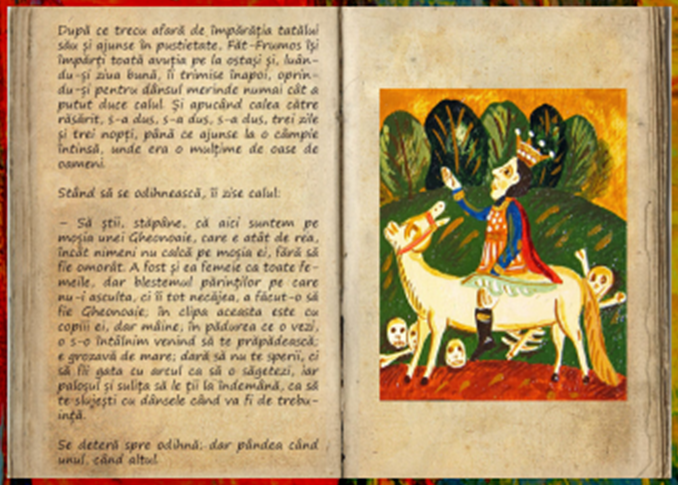
Silivestru Denisa
Colegiul Dobrogean “Spiru Haret”, Tulcea, Romania
…and myths
The master builder Manole
In Romanian mythology, Meșterul Manole (roughly: The master builder Manole) was the chief architect of the Curtea de Argeș Monastery in Wallachia. The myth of the cathedral’
s construction is expressed in the folk poem Monastirea Argeșului (“The Monastery on the Argeș River”): Prince Radu the Black (Radu Negru) wanted to build the most beautiful monastery in the country, so he hired Master Manole, the best mason of those times, along with his 9 men. During construction, because the walls of the monastery would continuously crumble, the Prince threatened to kill Manole
and his workers.Desperate about the way construction went, one night Manole had a dream in which he was told that, for the monastery to be built, he had to incorporate into its walls
some person very loved by him or his masons. He told his masons about his dream, and they agreed that the first wife who would come there with lunch for her husband the following day should be the one to be built into the walls of the monastery so that their art would last. The next day, Manole looked over the hills and sadly saw his wife, Ana (who was pregnant), coming from afar. He prayed to God to start rain and storm in order for her to stop her trip or go back home. But her love was stronger than the storm, and she kept going. He prayed again, but nothing could stop her. When she arrived, Manole and the builders told her that they wanted to play a little game, which involved building walls around her body. She accepted happily, but she soon realized
that this was no game and implored Manole to let her go. But he had to keep his promise. And that was how the beautiful monastery was built.When the monastery was completed, the Prince asked the builders if they could ever make a similarly splendid building. Manole and his masons told the Prince that they surely could always build an even greater building. Hearing that and fearing they’ll build a bigger and more beautiful building for someone else, the Prince had them all
stranded on the roof so that they would perish and never build something to match it. They fashioned wooden wings and tried to fly off the roof. But, one by one, they all fell to the ground. A well of clear water, named after Manole, is believed to mark the spot where Manole himself fell.

Silivestru Denisa
Colegiul Dobrogean “Spiru Haret”, Tulcea, Romania
Baba Dochia
Baba Dochia, or The Old Dokia, is a figure identified with the return of spring. The tradition says that you must pick a day from 1 to 9 March, and how the weather will be that day, so it will be for you all year long. There are a couple of legends linked to this period of the year. The most common one says that Dochia had a son, Dragobete, who married a girl. Dochia
mistreats her daughter-in-law sending her to pick berries in the woods at the end of February. God helps the girl to fulfill the task given by the old woman. When Dochia sees the fruits she believes that spring has come and leaves for the mountains with her sheep. She had dressed with 9 sheepskin
coats but as she climbed the mountains, the weather began to be warmer and warmer and each day she got off one coat until the 9th day when she remained only in a blouse. But in the evening, a cold wind started to blow as winter was still present. Then Baba Dochia, as well as all her sheep, got frozen and then turned into stone. On Bucegi Mountains, up on the plateau, there are some strange stone formations that apparently represent Baba Dochia and her sheep. Some say her spirit haunts every year around those days, bringing snowstorms and cold weather.

Silivestru Denisa
Colegiul Dobrogean “Spiru Haret”, Tulcea, Romania
Pacala
Pacala is a fictional character in Romanian culture, folklore, and literature. He is known for his humor and cleverness, hidden under a mask of naivety and simplicity. His name comes from the Romanian “a păcăli” – “to fool”. In the Romanian literature there are several anecdotes about Pacala, by authors such as Ion Creanga, Ioan Slavici, and Petre Dulfu. The legends of Pacala were an inspiration
for the two Romanian films “Pacala” (1974) and “Pacala is back”(2006).
Pacala is my favorite hero because of his unique way of dealing with life and the problems that come with it. If you will ever happen to want to read some Romanian literature, I strongly recommend you to make sure you don’t miss Pacala’s adventures. You’ll get some good laughs. And some wisdom.
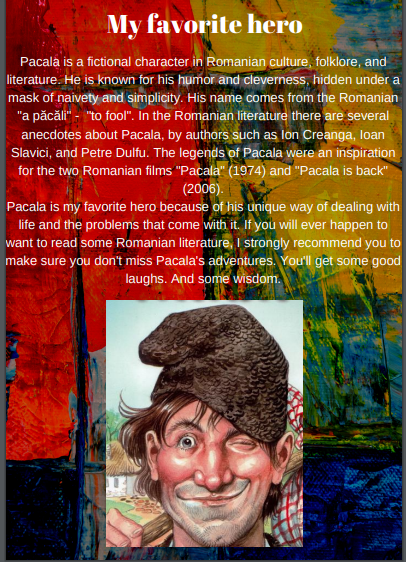
Chaimae Moumni
CIP Tafalla-Spain
Spanish myths: “Ratoncito Pérez”
In 1894, Luis Colomo told the story of Ratoncito Pérez to the young King Alphonso, who had just lost a tooth. Ratoncito Pérez was a mouse who lived in a box of cookies with his family in Madrid. He travels through the pipes of the city to reach the bedrooms of children who had just lost a tooth. When the children place their tooth under their pillows, Ratoncito Pérez exchange the tooth for a small gift. The character gained so much popularity that it was the first fictional character paid tribute to by the city council of Madrid with a commemorative plaque.
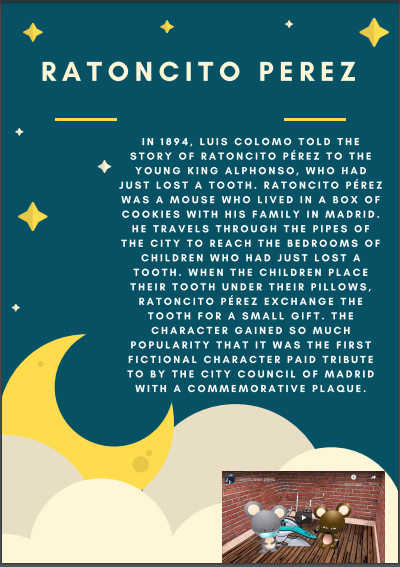
Antonela – Pino Repanić
I. gimnazija Split, Croatia
Babaroga
I am going to tell you about a mythical creature called Babaroga.
The Babaroga is a type of mythical creature used by adults to frighten children into good behavior. When you don’t listen to your parents or grandparents they say a babaroga will come and take you away from them.
Babaroga it same as Baba Jaga, one of the scariest creaturs in Slavic world. Baba Yaga is a supernatural being who appears as a deformed or ferocious-looking old woman. In Slavic culture, Baba Yaga lived in a hut usually described as standing on chicken legs. Baba Yaga may help or hinder those that encounter her or seek her out.
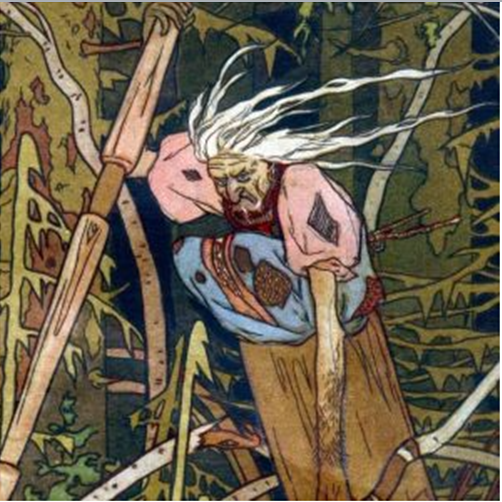
Matei Mihai
Colegiul National “Grigore Ghica”-Romania
Witches’ Pond
I’m going to tell you about the Witches’ Pond.
In the village of Boldeşti, in the middle of the Boldu Creţeasca forest, near Bucharest, 30 minutes away from the Cernica forest, there is a cursed countertop, recognized and feared by the locals even today. At the exit from the Capital, towards Ştefăneşti, in the Boldu-Creţeasca Forest, where it is believed that Vlad Ţepeş was beheaded, there is the Witches’ Pond. At first glance, the pond looks like an ordinary water eye of modest size, with a diameter of only 5 meters. Despite its usual appearance, the patch of water is said to be surrounded by forces from other worlds and is where inexplicable manifestations occur. On the night of St. Andrew, when portals open to other worlds and realities, when animals can speak, because the apostle is also their patron, witches gather to growth, luck, prosperity, attacks and aggressions, pacts with spirits from the world of shadow and darkness…. It seems that any curse, spell or release said at the edge of this pond is unmistakably fulfilled, also many animals refuse to drink water from this place. After the devastating 1977 earthquake, thousands of rubble dump trucks overturned in this pond, but strangely, they were swallowed by the swamp in a few months.

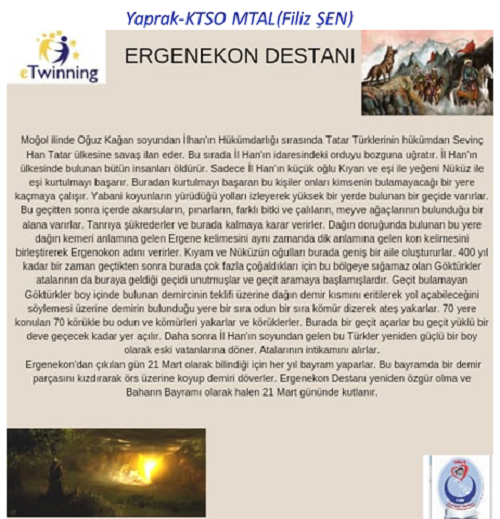
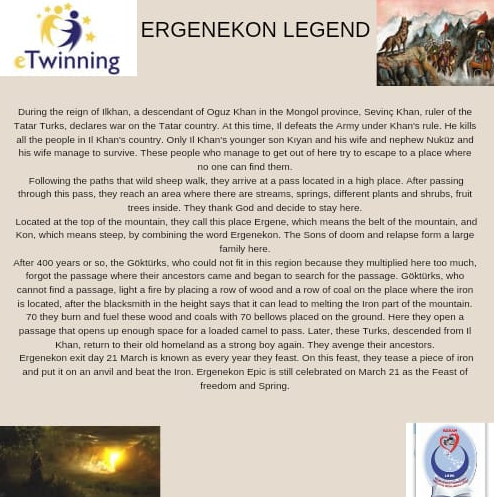
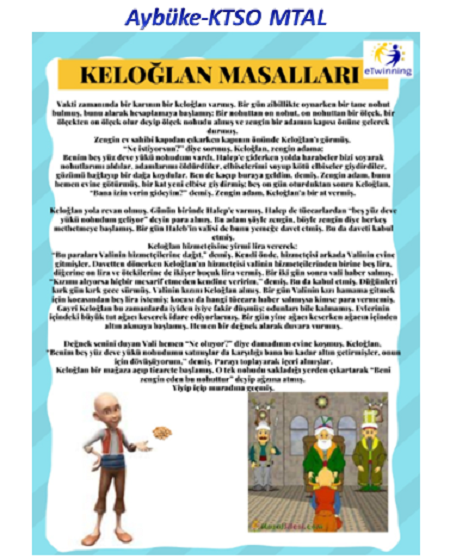

Suelnur Ü.- Fatma D.
Babaeski Şehit Ersan Yenici Anatolian High School, Kırklareli, Turkey
Nasreddin Hodja
Nasreddin Hodja lived in and around Akşehir in the 13th century. He is knowledgeable and quick-witted. His stories contain both humoral and advice. Nasreddin Hodja, one of the philosophers of Turkish-Islamic Culture, wise and master of humor, was born in Hortu Village of Sivrihisar District of Eskişehir in 1208.After working as an imam in his own village and Sivrihisar, he went to Akşehir to complete his education. He took lessons from the well-known scholars of the period here. After completing his education, he resided in Akşehir for a while and later worked as a teacher, clerk, professor, judge, and a knowledgeable person in courts in various parts of Anatolia. Nasreddin Hodja has become our national culture. It is known and loved in the Turkish World and the Islamic World. It is Molla Nasreddin in Azerbaijan, Koja Nasreddin in Kazakhstan, Nasreddin Efendi in Uzbekistan.Nasreddin Hodja is a legendary folk philosopher. There is a worldview in all his jokes. It responds to any excess with its opposite. It is constructive, not destructive. First it makes you laugh, then it makes you think. There is wisdom in every word. Every aspect of daily life takes place in his jokes. Nasreddin Hodja is the symbol of the Turkish nation’s sense of humor and intelligence. For this reason, he reappears in every age, and even the anecdotes that do not belong to him are transmitted under his name.Nasreddin Hodja died in 1284 in Akşehir and was buried in today’s Nasreddin Hodja Tomb.
Nasreddin Hoca
Nasreddin Hoca 13. yüzyılda Akşehir ve çevresinde yaşamıştır. Bilgili ve hazır cevaplı birisidir. Fıkraları hem mizah hem de öğüt içerir. Türk-İslam filozoflarından bilge ve mizah ustası Nasreddin Hoca, 1208 yılında Eskişehir’in Sivrihisar İlçesi Hortu Köyü’nde dünyaya gelmiştir. Kendi köyünde ve Sivrihisar’da imamlık yaptıktan sonra eğitimini tamamlamak için Akşehir’e gitti. Burada dönemin tanınmış bilginlerinden dersler aldı. Öğrenimini tamamladıktan sonra bir süre Akşehir’de ikamet etmiş, daha sonra Anadolu’nun çeşitli yerlerindeki hoca, kâtip, müderris, hâkim ve bilirkişi olarak görev yapmıştır. Nasreddin Hoca milli kültürümüzde yer almıştır. Türk Dünyasında ve İslam Dünyasında bilinir ve sevilir. Azerbaycan’da Molla Nasreddin, Kazakistan’da Koca Nasreddin, Özbekistan’da Nasreddin Efendi’dir. Nasreddin Hoca efsanevi bir halk filozofudur. Bütün şakalarında bir dünya görüşü var. Herhangi bir fazlalığa zıddıyla karşılık verir. Yapıcıdır, yıkıcı değildir. Önce güldürür, sonra düşündürür. Her kelimede bir bilgelik vardır. Günlük hayatın her yönü onun fıkralarında yer alır. Nasreddin Hoca, Türk milletinin mizah anlayışının ve zekasının simgesidir. Bu nedenle her çağda yeniden karşımıza çıkar ve hatta kendisine ait olmayan fıkralar bile onun adıyla nakledilir. Nasreddin Hoca 1284 yılında Akşehir’de vefat etmiş ve bugünkü Nasreddin Hoca Türbesi’ne defnedilmiştir.

Suelnur Ü.- Fatma D.
Babaeski Şehit Ersan Yenici Anatolian High School, Kırklareli, Turkey
Nasreddin Hodja Anecdote:
What if it does!
One day, Nasreddin Hodja goes to the shore of the lake.
He took a big spoonful of yogurt in his hand.
Nasreddin Hodja poured the yogurt in his spoon into the lake.
At that time one of the villagers saw him and, in amazement:
– Hodja asked what are you doing?
The hodja smiled:
– He said I’m adding yoghurt yeast to the lake.
The man looked at Hodja and laughed:
– Does the lake ferment? said.
Hodja
– But what if it is fermented, he said.
Nasreddin Hoca Fıkrası: Ya Tutarsa!
Nasreddin Hoca bir gün gölün kıyısına gider.
Eline bir kaşık yoğurt almış.
Nasreddin Hoca, kaşığındaki yoğurdu göle boşaltmış.
O sırada köylülerden biri onu görmüş ve şaşkınlıkla:
– Hoca ne yapıyorsun, diye sormuş.
Hoca gülümseyerek:
– Gölü mayalıyorum, demiş.
Adam, Hoca’ya bakmış ve kahkaha atarak:
– Göl hiç maya tutar mı?, demiş.
Hoca gülümsemesini hiç bozmadan:
– Peki ama ya tutarsa, demiş.
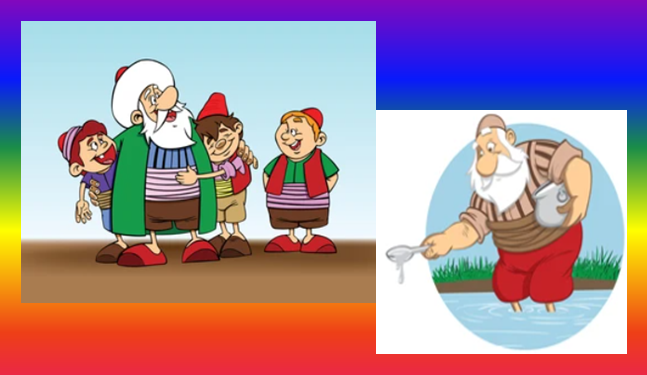
Schools that prepare content for our book:
AURELIA BAZBANELA
Tulcea, Romania
Colegiul Dobrogean „Spiru Haret”
Belgin Feyza Kurçenli
Edirne, Turkey
Edirne Sosyal Bilimler Lisesi
Bojana Stankic
Beograd, Serbia
Hemijsko-prehrambena tehnološka škola
Cristina Ionela Drăghici
Dorohoi, Romania
Colegiul National “Grigore Ghica”
Filiz ŞEN
Keşan, Turkey
Keşan Ticaret Ve Sanayi Odası Mesleki Ve Teknik Anadolu Lisesi
Francisco Javier Ballester López
Los Alcázares, Spain
IES Antonio Menárguez Costa
Gina Mouselimi
Kalamata, Greece
5ο Γυμνάσιο Καλαμάτας
Jorge Gomez Mateo
Los Alcázares, Spain
IES Antonio Menárguez Costa
Laura Odette Carrión Fernández
Los Alcázares, Spain
IES Antonio Menárguez Costa
Marian Úcar
Tafalla, Spain
CIP de Tafalla
Marisa Di Silvestre
Roseto degli Abruzzi (TE), Italy
IIS “Vincenzo Moretti” di Roseto Degli Abruzzi
OYA ARSLAN
Kırklareli, Turkey
Babaeski Şehit Ersan Yenici Anadolu Lisesi
Pino Repanić
Split, Croatia
I. gimnazija Split
Vesna Zivcic
Karlovac, Croatia
Glazbena škola Karlovac
Published: May 15, 2021
Latest Revision: May 22, 2021
Ourboox Unique Identifier: OB-1136621
Copyright © 2021








